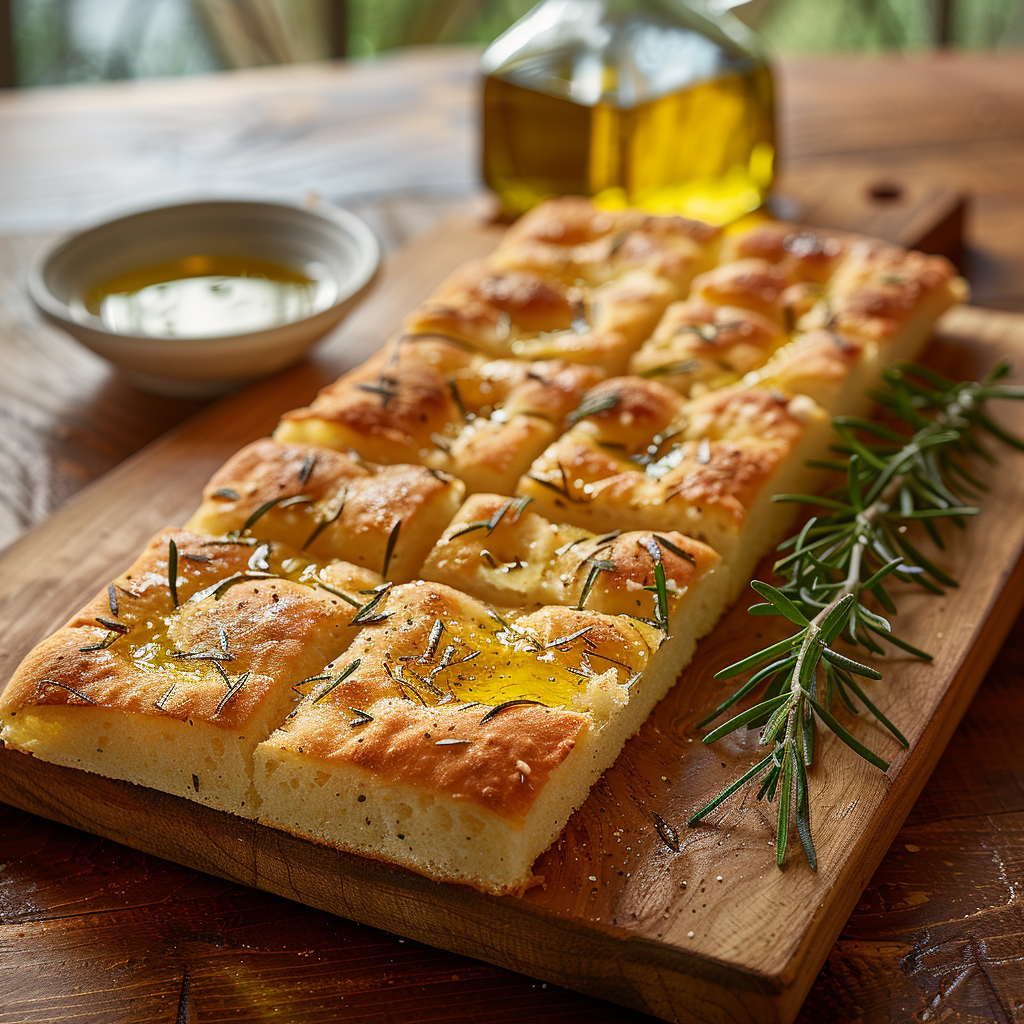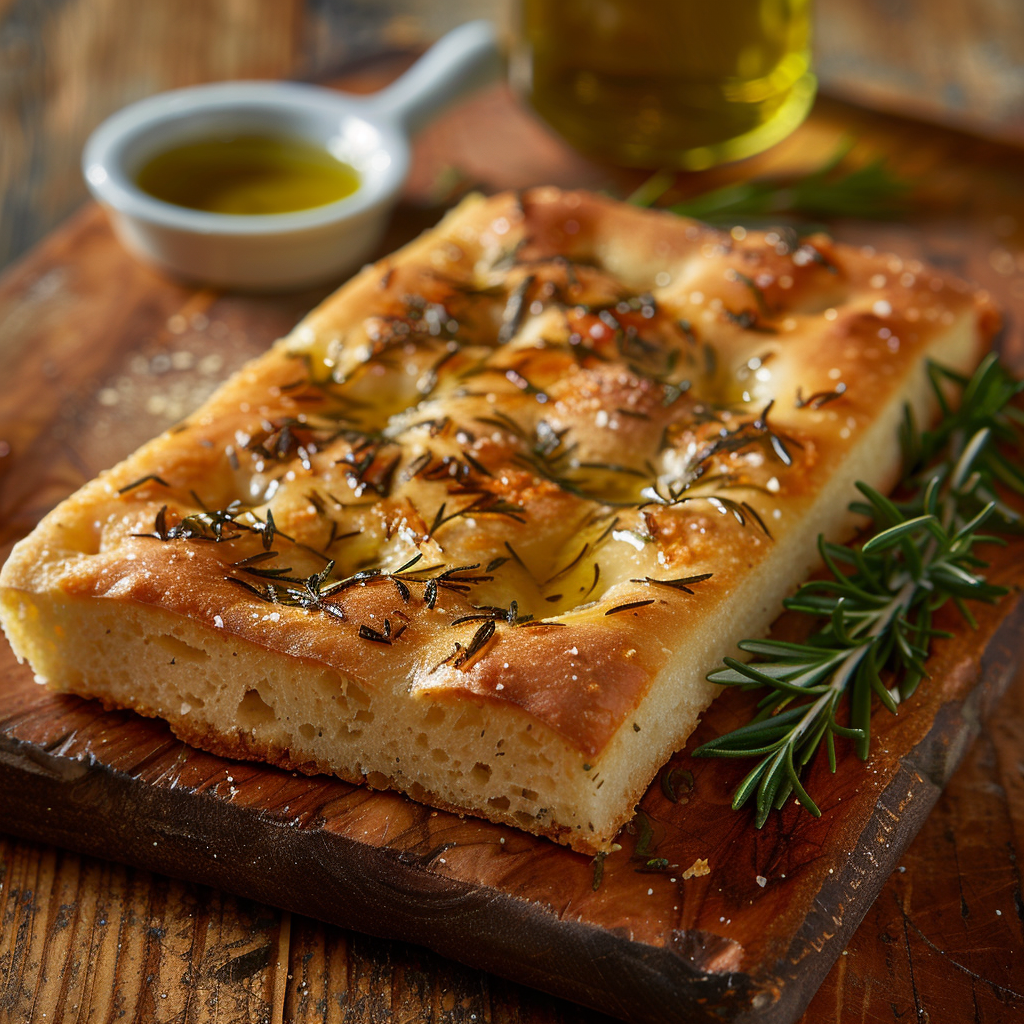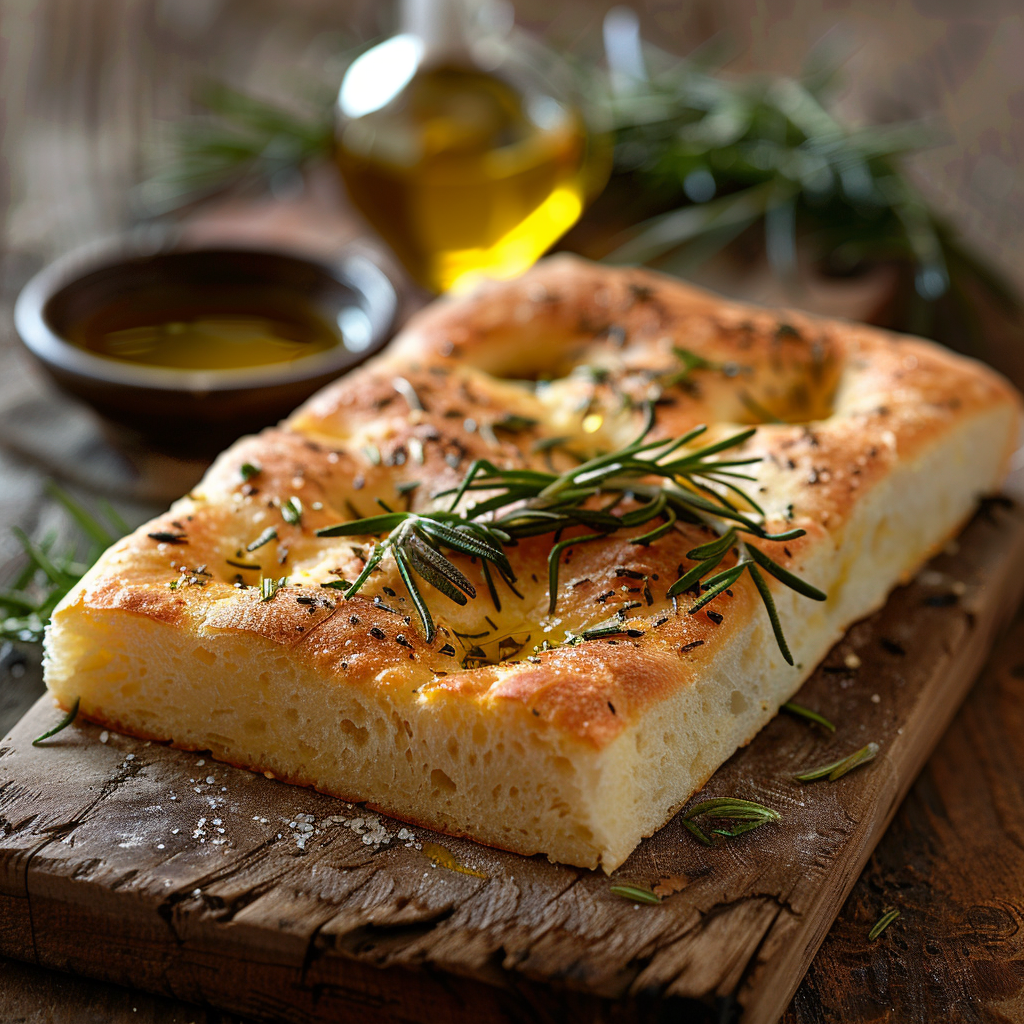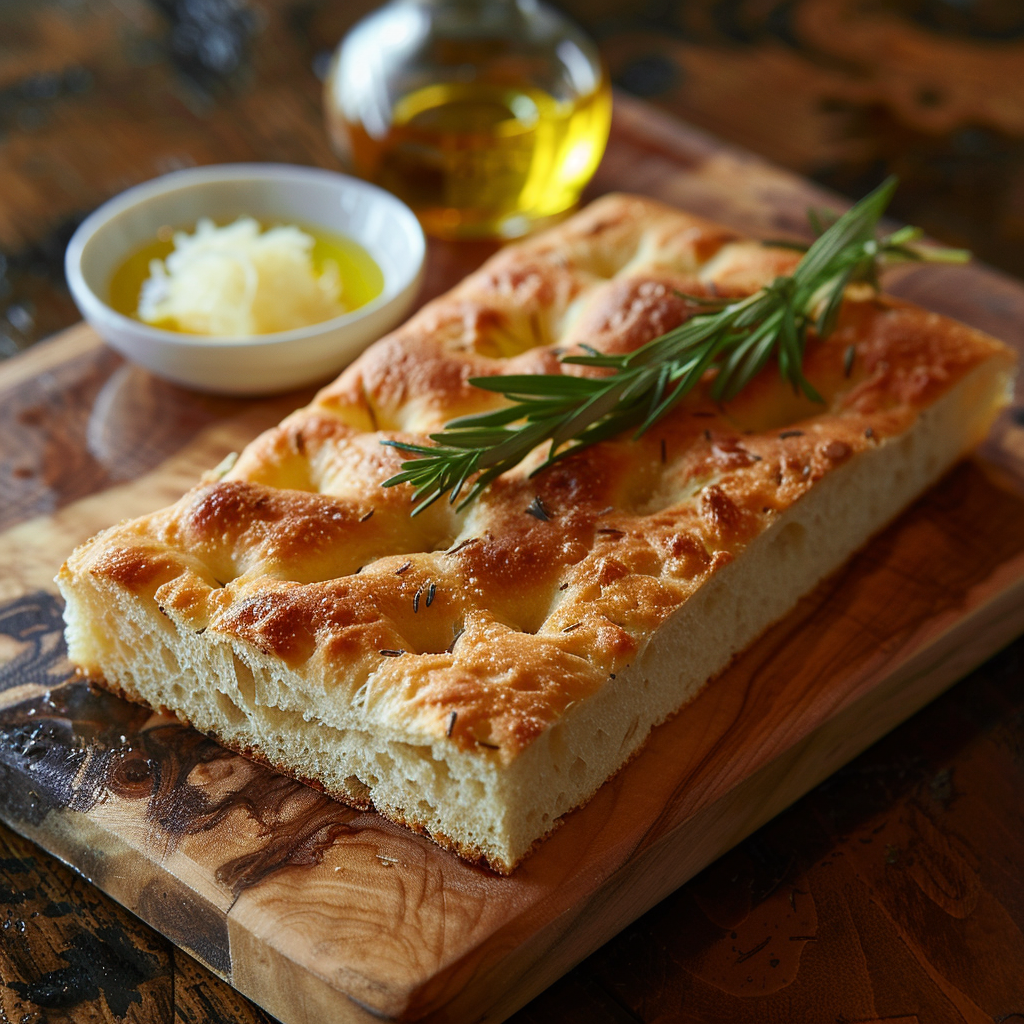Why This Rustic Italian Focaccia with Rosemary is a Game-Changer
You know those moments when the house smells so good you don’t want to leave? That’s exactly what happened when I baked this Rustic Italian Focaccia with Rosemary for the first time. My kitchen was filled with the aroma of olive oil, fresh rosemary, and warm bread. It felt like Italy had dropped by for a visit! This recipe isn’t just about making bread—it’s about creating memories. Whether you’re new to baking or a seasoned pro, this focaccia will win your heart.
The Story Behind Rustic Italian Focaccia with Rosemary
Focaccia hails from Italy, where it’s been a staple for centuries. Back in the day, Italian bakers would use simple ingredients like flour, water, and olive oil to create this flatbread masterpiece. Over time, people added herbs like rosemary to give it extra flair. When I visited Tuscany years ago, I fell in love with the rustic charm of focaccia served at a tiny bakery. The baker told me his secret: “Let the dough rest, and let your soul rest too.” Ever since, I’ve been perfecting this recipe to bring that same magic to my family table.
Why You’ll Love This Recipe
This Rustic Italian Focaccia with Rosemary is all about simplicity and flavor. You only need a handful of ingredients, but the result is pure magic. The crust is golden and crispy, while the inside is soft and pillowy. The fragrant rosemary adds a woodsy touch, and the olive oil gives it a rich, savory finish. Plus, it’s fun to make! Kneading the dough and dimpling the surface feels like a mini therapy session. Trust me, once you try it, you’ll be hooked.
Perfect Occasions to Make This Focaccia
This focaccia is perfect for any occasion—or no occasion at all! Serve it as an appetizer at dinner parties, slice it up for picnics, or enjoy it alongside soups and salads. I love making it for Sunday brunches because it pairs beautifully with eggs and avocado. It’s also a hit during holidays when everyone craves something homemade and comforting. Honestly, there’s never a bad time to bake this beauty!
Ingredients
- 4 cups all-purpose flour
- 1 ½ cups warm water
- ¼ cup extra virgin olive oil, plus more for drizzling
- 2 teaspoons salt
- 2 teaspoons sugar
- 2 ¼ teaspoons active dry yeast
- 3 tablespoons fresh rosemary leaves
- Coarse sea salt for sprinkling
Substitution Options
- Flour: Swap half the all-purpose flour with whole wheat flour for a nuttier taste.
- Rosemary: Use thyme or oregano if you’re out of rosemary.
- Olive Oil: Any mild vegetable oil works in a pinch.
Preparation Section
Step 1: Activate the Yeast
Pour the warm water into a mixing bowl and sprinkle the sugar and yeast over it. Let it sit for about 5 minutes until it becomes frothy. This step ensures your dough rises properly. If it doesn’t foam, your yeast might be old—check the expiration date! Pro tip: Use a thermometer to ensure the water is around 110°F (43°C). Too hot, and you’ll kill the yeast; too cold, and it won’t activate.
Step 2: Mix the Dough
Add the flour, salt, and olive oil to the bowl. Stir everything together until a shaggy dough forms. Then, knead it on a floured surface for about 8–10 minutes until smooth and elastic. The dough should feel soft and slightly sticky, like a warm hug. Don’t rush this step—it’s crucial for developing gluten, which gives the focaccia its structure.
Step 3: Let It Rise
Place the dough in a greased bowl, cover it with a damp towel, and let it rise for 1–2 hours until it doubles in size. Find a cozy spot away from drafts. While waiting, take a moment to relax—this is part of the process! Chef’s tip: Play some music or read a book while the dough does its thing.
Step 4: Shape and Dimple
Once risen, transfer the dough to a greased baking sheet. Gently stretch it into a rectangle or oval shape. Use your fingers to press dimples all over the surface. These little indentations catch the olive oil and make the focaccia look rustic and inviting. Sprinkle fresh rosemary and coarse sea salt generously on top.
Step 5: Bake to Perfection
Drizzle the focaccia with olive oil and bake it in a preheated oven at 425°F (220°C) for 20–25 minutes. Keep an eye on it—the edges should turn golden brown, and the aroma will fill your home. Once done, let it cool slightly before slicing. Pro tip: Use a sharp knife or serrated blade for clean cuts.
Timing
Here’s a quick breakdown of the timing:
- Prep Time: 20 minutes
- Rising Time: 1–2 hours
- Baking Time: 20–25 minutes
- Total Time: About 2–3 hours
Chef’s Secret
For an extra burst of flavor, add minced garlic to the olive oil before drizzling it over the focaccia. Trust me, it’s heavenly!
Extra Info
Did you know that focaccia is often considered the ancestor of modern pizza? Both share similar origins and methods, though focaccia remains simpler and flatter. Isn’t that fascinating?
Necessary Equipment
- Mixing bowls
- Baking sheet
- Rolling pin (optional)
- Damp towel
- Oven
Storage
To keep your Rustic Italian Focaccia with Rosemary fresh, store it in an airtight container at room temperature for up to two days. After that, it’s best to freeze it. Wrap slices tightly in plastic wrap and place them in a freezer-safe bag. They’ll stay good for up to three months.
If you plan to reheat it, pop it in the oven at 350°F (175°C) for 5–10 minutes. This restores its crispiness beautifully. Avoid microwaving, as it can make the bread soggy.
Pro tip: Freeze individual slices wrapped in parchment paper for easy grab-and-go snacks.
Tips and Advice
Always measure your ingredients accurately—baking is a science! If your dough feels too sticky, add a bit more flour, one tablespoon at a time. On the flip side, if it’s too dry, add a teaspoon of water. Patience is key; rushing the rising process can lead to dense bread.
Presentation Tips
- Serve the focaccia on a wooden board for a rustic vibe.
- Garnish with additional fresh rosemary sprigs for color.
- Pair it with dipping oils or balsamic vinegar for elegance.
Healthier Alternative Recipes
Want to tweak this recipe? Here are six healthier variations:
- Whole Wheat Focaccia: Replace half the flour with whole wheat for added fiber.
- Gluten-Free Focaccia: Use a gluten-free flour blend designed for baking.
- Low-Sodium Option: Cut the salt in half and skip the coarse sea salt topping.
- Vegan Focaccia: This recipe is already vegan—just double-check your ingredients.
- Herb-Infused Focaccia: Add dried basil or parsley for variety.
- Seed-Topped Focaccia: Sprinkle sesame or sunflower seeds for crunch and nutrition.
Common Mistakes to Avoid
Mistake 1: Using Cold Water
Yeast needs warmth to activate. If you use cold water, your dough won’t rise properly. Always aim for lukewarm water between 105°F and 115°F (40°C–46°C). Pro tip: Test the water with your finger—it should feel pleasantly warm, not scalding.
Mistake 2: Skipping the Rest
Don’t rush the rising process. If you skip letting the dough rest, your focaccia will end up dense and flat. Give it the full 1–2 hours to double in size.
Mistake 3: Overloading Toppings
While toppings are delicious, adding too much can weigh down the dough. Stick to a light sprinkling of rosemary and sea salt for the best texture.
FAQ
What makes focaccia different from other breads?
Focaccia is unique because of its flat shape, dimpled surface, and generous use of olive oil. Unlike sandwich bread, it has a softer interior and crispier crust, making it ideal for snacking or serving alongside meals.
Can I make this recipe ahead of time?
Absolutely! You can prepare the dough a day in advance and refrigerate it overnight. Just let it come to room temperature before shaping and baking.
How do I know when the focaccia is done?
Look for a deep golden-brown color and listen for a hollow sound when tapping the bottom. If unsure, insert a thermometer—the internal temperature should reach 190°F (88°C).
Is this recipe beginner-friendly?
Yes! With clear instructions and minimal equipment, even novice bakers can master this Rustic Italian Focaccia with Rosemary. Plus, the rewards are totally worth it.
Can I freeze leftovers?
Definitely! Wrap slices individually and freeze them for up to three months. Reheat in the oven for best results.
What dishes pair well with focaccia?
Focaccia complements soups, stews, salads, and pasta dishes. It’s also great on its own with dips like hummus or marinara sauce.
Do I need special tools?
No fancy gadgets required! Just basic kitchen tools like bowls, a baking sheet, and a rolling pin (if desired).
Why is my focaccia too dense?
Dense focaccia usually happens due to insufficient rising time or using expired yeast. Ensure your yeast is fresh and give the dough ample time to rise.
Can I use dried rosemary instead of fresh?
Yes, but reduce the amount since dried herbs are more potent. One tablespoon of dried rosemary equals about three tablespoons of fresh.
What’s the best way to serve focaccia?
Slice it into squares or rectangles and serve warm. Pair it with cheeses, cured meats, or roasted vegetables for a delightful spread.
Final Thoughts
Baking this Rustic Italian Focaccia with Rosemary is more than just cooking—it’s about creating joy. From the soothing rhythm of kneading dough to the mouthwatering smell that fills your home, every step brings satisfaction. So roll up your sleeves, gather your ingredients, and treat yourself to a slice of Italy. Buon appetito!

Rustic Italian Focaccia with Rosemary
Ingredients
Equipment
Method
- Pour warm water into a mixing bowl and sprinkle sugar and yeast over it. Let sit for about 5 minutes until frothy.
- Add flour, salt, and olive oil to the bowl. Stir until a shaggy dough forms, then knead on a floured surface for about 8–10 minutes until smooth and elastic.
- Place dough in a greased bowl, cover with a damp towel, and let rise for 1–2 hours until doubled in size.
- Transfer risen dough to a greased baking sheet and gently stretch into a rectangle or oval shape. Use fingers to dimple the surface.
- Sprinkle fresh rosemary and coarse sea salt generously on top, then drizzle with olive oil.
- Bake in a preheated oven at 425°F (220°C) for 20–25 minutes until golden brown. Let cool slightly before slicing.



